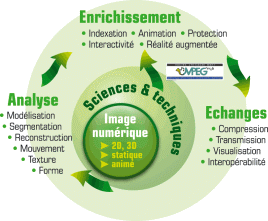Research
Research overview
|
 |
The core of ARTEMIS research activities concerns Digital Imaging Sciences and Technologies. These technologies pose significant challenges to economic and academic players who need to design innovative methods and new services for the information society.
Today, digital imaging covers a broad spectrum of visual data: 2D (radiography, photo, etc.) or 3D (industrial CAD, video game objects, etc.), static (photos, drawings, etc.) or animated (videos, dynamic meshes, deformable objects, etc.), natural (from the physical world) or synthetic (computer-generated),in a fixed or mobile environment. ARTEMIS deals with the image chain, from the creation of digital contents to their transmission.
The challenge is to create, model, analyze, index, animate, protect, manipulate, enrich, encode, distribute and visualize heterogeneous and complex contents for economically viable emerging services.
| The main properties and constraints that need to be mastered are: |
♦
|
scalability in the context of very large-scale databases, |
| ♦ |
management of asynchronism, |
| ♦ |
user-friendly and intuitive interactivity, |
| ♦ |
confidentiality and security, |
| ♦ |
access by the end-user to his/her usual personalized environment irrespective of the platform used, |
| ♦ |
adaptation of quality of service according to available resources: transmission, processing, display capacities, etc. |
In order to contribute to this rapidly evolving field, ARTEMIS deploys a wide range of expertise.
|
◊ Scientific expertise
|
 |
 |
This expertise lies in three areas: |
| ♦ |
visual content analysis: modeling, reconstruction, shape / motion / texture segmentation, registration. |
| ♦ |
multimedia content enrichment: indexing, protection, animation, interactivity, augmented reality. |
| ♦ |
multimedia content exchange: compression, transmission, visualization, interoperability. |
| |
Mastering the bilateral analysis-exchange, analysis-enrichment, enrichment-exchange interactions, ARTEMIS owns a global expertise in the digital image production chain. |
In recognition of its achievements, ARTEMIS has been awarded the Marie Curie Training Site label by the European Community. This label acknowledges the laboratories that combine scientific reputation with proven experience in doctoral training programs in a European context.
|
◊ Application areas
|
 |
| ♦ |
Communicating Society: intelligent archiving, secure video services on mobile terminals, virtual signing- and lips reading-based communication systems for the hearing-impaired, remote-assistance, telesurveillance. |
| ♦ |
Culture and entertainment: online gaming, interactive digital television, cartoon creation, video on demand on ADSL. |
| ♦ |
e-health and biosciences: computer-assisted diagnosis in cardiology, pneumology and neurology, genomics, etc. |
|
Last modify October 8, 2012



![[del.icio.us]](https://artemis.telecom-sudparis.eu/wp-content/plugins/bookmarkify/delicious.png)
![[Digg]](https://artemis.telecom-sudparis.eu/wp-content/plugins/bookmarkify/digg.png)
![[Facebook]](https://artemis.telecom-sudparis.eu/wp-content/plugins/bookmarkify/facebook.png)
![[Google]](https://artemis.telecom-sudparis.eu/wp-content/plugins/bookmarkify/google.png)
![[Jamespot]](https://artemis.telecom-sudparis.eu/wp-content/plugins/bookmarkify/jamespot.png)
![[LinkedIn]](https://artemis.telecom-sudparis.eu/wp-content/plugins/bookmarkify/linkedin.png)
![[MySpace]](https://artemis.telecom-sudparis.eu/wp-content/plugins/bookmarkify/myspace.png)
![[Reddit]](https://artemis.telecom-sudparis.eu/wp-content/plugins/bookmarkify/reddit.png)
![[Technorati]](https://artemis.telecom-sudparis.eu/wp-content/plugins/bookmarkify/technorati.png)
![[Twitter]](https://artemis.telecom-sudparis.eu/wp-content/plugins/bookmarkify/twitter.png)
![[Email]](https://artemis.telecom-sudparis.eu/wp-content/plugins/bookmarkify/email.png)